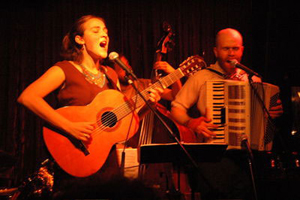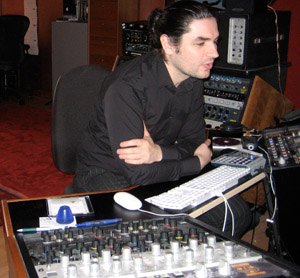In-Session: Becca Stevens Mixing At Flux Studios
EAST VILLAGE, MANHATTAN — In the Spring, we met with singer and songwriter Becca Stevens during mix sessions at Flux Studios for her upcoming album with the Becca Stevens Band. Flux owner/engineer/producer Fabrice “Fab” Dupont was mixing the record with jazz producer Matt Pierson (Jane Monheit, Brad Mehldau, Joshua Redman) when we stole Stevens away for a chat.
Our advice for those who’ve never seen Stevens live: run don’t walk. We first encountered her as the lead vocalist in Travis Sullivan’s Bjorkestra (billed “visionary pop meets cutting edge jazz”) in a performance at BAM last year.
Channeling the Icelandic avant-pop artist in an orchestral jazz setting, Stevens was totally enchanting, her voice taking the other-worldly experience of Bjork to yet another world, offering a new experience of the music without losing fans of the original.
Looking further, we discovered The Bjorkestra is just one of several NYC jazz and experimental/acoustic ensembles that feature Stevens on vocals. A graduate of The New School for Jazz and Contemporary Music, Stevens lends her voice to experimental/ambient group David Moore‘s Bing & Ruth, jazz saxophonist Logan Richardson, jazz pianist Elan Mehler, jazz pianist Taylor Eigsti, Sam Sadigursky‘s “Words Project,” and pianist Gideon Van Gelder, to name just a few of her collaborations.
Then, there’s Stevens’ own band, which plays to her classical guitar and Appalachian folk roots and her propensity for jazz and eclectic pop to produce a unique, hard-to-classify sound. Whatever the predominant style of each song, Stevens’ songwriting features the voice as its primary instrument. And the new recordings showcase her voice exquisitely in both the more wistful, intimate moments with sparing strings and percussion as well as in lush harmony with her bandmates, full band kicking in.
We spoke with Stevens and Dupont about making the record — first sitting down with Stevens inside Flux and then following up with Dupont post-mix. Read all about it:
Your new record features cover songs as well as originals, that right? I heard your rendition of Joni Mitchell’s “Help Me” — it’s amazing. Tell us about the record and where the idea for the covers comes from.
Becca Stevens: Six of the songs on the record are covers, and the rest are my originals. We’ve [The Becca Stevens Band] been doing a monthly gig at 55 Bar and I had this idea that, to fill out our repertoire — since it’s two sets of music — we should try to learn and arrange a new cover as a band every month. Six months into that, we decided to record and Matt [Pierson] suggested we record our covers too. They’re fun covers but they still sound like the band.
One of them is “Help Me.” I’d gotten a book of Joni Mitchell tunes and was sitting on my bed looking through it with my ukulele and I started playing that one and felt it really worked on ukulele. We also do The Smiths’ “There is a Light,” which is something I’ve been covering for a long time. And Seal’s “Kiss From a Rose” — Liam Robinson [Becca Stevens Band] was reminded of how great the song was when he heard it on the radio and suggested we give it a whirl. I started arranging it the next day when I was doing the dishes and then we arranged the vocal parts as a band. I think it ended up being a really cool cover.
Is there any one spin you’re putting on these cover songs? Like, how would you classify your band’s sound?
One of the key points of the band’s sound is that we sing so much. The guys are singing with me almost the whole time. That’s something that I like to hear in music; I always hear the vocal lines because I’m a singer. I also play guitar, ukulele and charango. Liam Robinson plays the accordion and piano and overdubs some other keyed instruments; Jordan Perlson plays percussion and drums and Chris Tordini plays acoustic bass, and we all sing.
Was there anything you had in mind when you started working with Matt in terms of what kind of sound you were going for on this record, overall?
I knew what I wanted to avoid: having a “jazz sound”, or having an effected sound or too many overdubs or special guests. I wanted keep as close to our band sound as possible. And I wanted it to sound as much like something we could perform live as possible, without limiting ourselves. The studio holds all these possibilities, opportunities that you can’t take advantage of when you’re playing live, so I did want to explore some of that. I wanted a balance.
So you recorded at Sear Sound and Brooklyn Recording — did the band play these songs live?
We recorded all together as a band until we had a track that felt really good. Then Chris and Liam and I would track our vocals over the rhythm section tracks from that take. I was isolated completely and Chris and Liam were in the big room together. Even though I was isolated from the guys we tracked our vocal overdubs together to keep the live energy.
And then you’ve been holding to that in the mixing process? Like staying away from anything that sounds overly produced?
Definitely. I have an aversion to reverb, but I’m learning from working with Fab that there are good reverbs and bad reverbs and that there’s a certain amount of necessity to a small amount of reverb because it does things to the voice that are pleasing to the ear. Where having it completely dry it sounds almost as if it’s wrapped around your head, having a little bit of reverb — even if it’s unnoticeable in the sense of hearing a delay — the voice feels all of a sudden like it’s in a big room, and you can feel the space around your head. And it can also make the voice sound more present.
I’ve been more open-minded about it and I’ve ended up coming to a place that I really, really like.
Did you do anything different on this record than ever before?
Yes, I used a producer.
And how has that affected things?
The efficiency — we’re moving so fast! I actually recorded seven of these songs prior to meeting Matt, and I decided to take on editing myself to save money. That was like 8 months ago and I was still working on the editing of the third song when I met Matt. It was going so slowly. I’d never done it before and I didn’t really have the time to be doing it. And I was the only person hearing it, so I was getting stuck in this place where I was doubting myself, thinking do i like this? And then I’d hear it 100 more times and not know what to think.
During this session, if my ears were shot, Matt could go in and work on something with Fab and then call me in to come hear it with fresh ears. I’d come in with a pad and take notes on what I like and don’t like. Also to have someone in there during the actual recording, to keep things on track (no pun intended) was really helpful as well.
When do you hope to put the record out and then what?
We’re hoping to release it in the Fall. I’m looking into labels with Matt and trying to decide what makes the most sense for us in that department. I really want to tour with this band. And I look forward to finishing this record so I can start writing new music! In New York, I’d like to branch out and play bigger venues like Le Poisson Rouge and Joe’s Pub. I like to play in venues with great sound systems, but It’s also a treat for us to play completely acoustic. It’s hard to find a nice room that has a good sound system that’s not also a bar where people will be talking over the music. I like listening venues.
*****
Post-mixing, we caught up with Fab Dupont and talked about what it was like working with Stevens and Pierson on this record.
So you mixed the Becca Stevens Band album — what was this process like?
Fabrice “Fab” Dupont: Yes, Meredith McCandless did all the editing and then I mixed it — 17 songs in 6 days, if you can believe that. We’ve worked with the producer, Matt Pierson, on a few projects this year, including the new Kirk Whalum record, and a few records that we did entirely in-house — track, mix, master — and in just a few days (Com Voce, David Caceres). We understand each other really well now and have figured out a process that works really well. I think Matt is one of the best jazz and acoustic music producers around.
How so? What makes him so good at what he does?
He’s got the things that are no longer around — a lot of experience, but still a lot of curiosity, and an ear for new music. He has roots in the past but he’s not turned toward the past — he comes in and he’s listening to Phoenix on his iPod. And he has the best rolodex on earth. He can smell talent from across a room. That was his job as the head of Warner Jazz for many years, so he’s been able to find great talent and work with the best. He knows from the live show how good a record can be.
So, does he try to make jazz records that sounds like the live performance sound?
No, I think he’s just trying to make records that people want to hear. This is actually a very different thing than making a recording of a live performance. I think a producer is the person who’s hired to compensate for the fact that when you’re going to listen to the record in your home, the performer will not be there. He’s the guy that makes that okay!
So what was unique about mixing this record and working with Becca’s voice and band?
Definitely it was the purity of it all. Also, it didn’t come with a bunch of references — they just said ‘here are the files,’ and then I did my thing. There was a little bit of back and forth about how much reverb and how loud the vocals should be. But basically everyone on the project was able to impart the aesthetic.
What was your approach on reverb for this record? Becca says she had an aversion to it coming into the project.
Well, there is no such thing as the right amount of reverb, universally. It’s more figuring out what is the right amount of reverb for this record, to be able to convey that emotion without it feeling too raw or too close. I wanted Becca’s record to sound as if she’s sitting on your knees singing to you but then also I wanted it to be larger than life so she comes across as supernatural as she really is, which is pretty supernatural! I also wanted it to sound completely undoctored.
So what reverbs did you use to achieve the right balance?
We have an EMT stereo plate at Flux and I used that, on a very short setting. I turned the wheel down to be quite short; pretty much the opposite of what most people would use a plate for. But I really like what it did — it was very natural, and also had the great advantage of not being tweakable. I put the plate on one setting and kept it there. So that was it. Old school.
I also used my AKG spring reverb (BX10) and, otherwise, the Oxford [Sonnox Oxford Reverb] plug-in which is totally amazing. I also used the UAD EMT 250 emulation. This plug-in is totally off the hook, absolutely surreal, really great. So there are four reverbs on that record even though you don’t hear any of them.
And you get your tweakability with the software reverbs?
Yes, so I used the real plate as the main ambience for everybody then the 250 plug-in whenever I needed more of a tail. And I have a certain kind of really short reverb on the Oxford that I use as kind of a back-wall deal, to add openness on elements that were close miked in the recording.
****
Catch the Becca Stevens Band the Third Friday of every month at 55 Bar; she’ll also be touring with Taylor Eigsti this month. Visit her at http://www.myspace.com/beccastevens and check out a few of the band’s performances on YouTube. And, for more on Fab, who recently produced/engineered a record with South Africa’s Freshly Ground, and engineered their collaboration with Shakira for the Official World Cup Song, visit http://fabulousaudioblog.blogspot.com.
Please note: When you buy products through links on this page, we may earn an affiliate commission.









